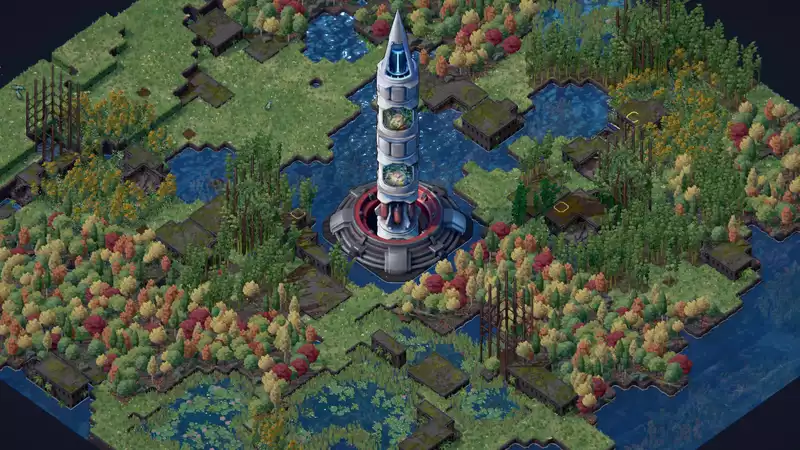Sometimes you just want to play a game alone and relax. Less pressure, pleasant sounds, and plenty of challenge. The environmental strategy puzzle "Terra Nil" meets those very requirements, and is a refreshingly low-key breeze to the city builder genre.
Officially billed as a "reverse city builder," it is not inaccurate to describe Terra Nil as such. It is a game of consuming and generating resources and building a chain of synergistic structures to achieve numerical goals. Despite this, I feel that Terra Nil owes much to puzzle games and solitaire.
Stripped down to its barest mechanical bones, it is a puzzle game of order of operations, rolling procedurally generated punches to clear the board in the fewest possible moves. It is the kind of game that is played alone, quietly and thoughtfully, placing everything in the correct order and moving on.
It is also a meditation on what our species brings to this world: your goal in Terra Nil is not to build the biggest, most profitable business or to defeat your enemies. Rather, it is to take a barren, toxic wasteland, restore it to its natural state, reintroduce animals, and carefully unravel your work so that not a single trace of man-made machinery remains. The loop of restoring beauty and then cleaning up proved surprisingly compelling as a game.
Terra Nil is slight and focused, at least compared to many works that advocate strategy. There are only four missions to play in sequence at the beginning (which take roughly four to six hours, and four more variant missions are unlocked after the credits roll), each in a different procedurally generated environment (temperate, tropical, polar, continental). Each environment requires different techniques and equipment to revive, and each has a different palette of tools and structures to use.
Each genesis project proceeds in a three-step process. Starting from a lifeless isometric canvas, the first step is to restore basic climate and necessary greenery by installing toxin removal and irrigation equipment (followed by dredging the seabed to create new land). If funds are exhausted, some of the structures can be reused on lower difficulties, but on higher difficulties, overexpansion will result in a failed state, forcing a complete redo. While never too difficult, there is always a concern.
Once enough green and blue foundations have been laid, new sets of structures are unlocked (different sets for different missions and variations), allowing for further manipulation of the environment and the growth of different types of habitats to meet their respective quotas. Finally, each mission will ask you to scan the environment you have created to find ideal habitats for different animals and clean them up using natural rivers or your own monorail system.
"Terra Nil" is very good at conveying its message through mechanics. The system is introduced through a beautifully illustrated notebook, and we are encouraged to look at the beauty of the natural world. While you could force your way to success and cover the entire map with a grid of scrubbers and irrigation systems, it is far more efficient to give nature a little nudge in the right direction. Careful placement of cloud seeders along the water's edge won't do much at first, but as the humidity rises, nature's rain will begin to fall again, and if you sit back for a while and let nature take over while enjoying the ASMR vibes of the rain, the entire map will be cleansed.
Therein lies the joy of terra nil. While just completing each mission was relatively easy (although it could have been made harder by fine-tuning the difficulty level, limiting resources, and making choices more critical), it was always satisfying to find mechanisms in each environment to make nature do the heavy lifting. A well placed water pump on a hilltop could fill multiple rivers and lakes. A controlled wildfire can turn an entire forest into fertile ground. You are not building a base, you are initiating a natural process. And perhaps learn a little about how these environments were formed in the first place.
It is also an interesting game to play over and over again, although one worries a bit about diminishing returns. The randomly generated maps provide a unique challenge, with strategy often dictated by the placement of natural lakes and rivers. But like a good solitaire game, unpredictability and adaptation to chance are part of the fun.
This random aspect of Terranil is not always rewarded as welcome variety. While it is possible to get a passing grade on most missions, the highest scores (which require creating all animal habitats and meeting all climate targets) can require very specific arrangements of adjacent biomes.
Nevertheless, it was seldom more than a small obstacle that made scoring 100% a little difficult. Other than that, the experience was consistently relaxing and satisfying.
Terra Nil is not a game with grand ambitions, nor does it challenge Civilization's One More Turn forced loop or replace Anno as an all-consuming time sponge, but it does not aim to do so. That theme is well reflected in the design. Sometimes, the more you are having fun, the better it is to put it away when you are done and move on. Not everything has to go on forever or grow endlessly. Stepping back gracefully can bring its own satisfaction.
.

Comments